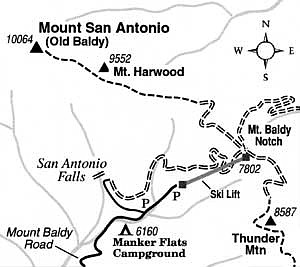 Facebook
Facebook
 X
X
 Instagram
Instagram
 TikTok
TikTok
 Youtube
Youtube
No Southern California hiker's repertoire of experiences is complete without at least one ascent of Mount San Antonio, or "Old Baldy." At 10,064 feet, Baldy's summit looms large over the eastern Los Angeles Basin, the Inland Empire communities of Riverside and San Bernardino, and the western Mojave Desert. The mountain can be seen as far north as the southern Sierra Nevada and as far south as the Mexican border. Those facts indicate how magnificent the view from the top can be on a clear day. The east, or Devil's Backbone, approach described here is the least taxing of the several routes to the summit, but it's by no means a picnic. You start at 7800 feet, with virtually no altitude acclimatization, and climb expeditiously to over 10,000 feet in just over three miles.
By driving northbound on either Mills Avenue in Claremont, Mountain Avenue in Upland, or Euclid Avenue in Upland, you will eventually converge on Mount Baldy Road, which heads steeply uphill. Continue through the village of Mount Baldy and beyond to where the road ends in the parking lot of the Mount Baldy Ski Lift. The lift (on weekends during summer, 9:00 a.m. to 4:45 p.m.) will take you to the restaurant/lodge at Mount Baldy Notch, elevation 7800 feet. If it's a weekday, or you don't like being dangled over an abyss, you can always walk up the ski lift maintenance road. That option adds 3.6 miles and an elevation change of about 1600 feet both on the way up and on the way down.
From Mount Baldy Notch, start hiking on a maintenance road to the northwest that climbs moderately, then more steeply through groves of Jeffrey pine and incense cedar. After a couple of bends, you come to the road's end (1.3 miles) and the beginning of the trail along the Devil's Backbone ridge. The stretch ahead, once a hair-raiser, lost most of its terror when the Civilian Conservation Corps constructed a wider and safer trail, complete with guardrails, in 1935-36. The guardrails are gone now, but there's still enough room to maneuver safely.
The backbone section ends at about 2.0 miles as you start traversing the broad south flank of Mount Harwood. Scattered lodgepole pines now predominate. At 2.6 miles you arrive at the saddle between Harwood and Old Baldy, where backpackers sometimes set up camp (no water, no facilities here). Continue climbing sharply up the rocky ridge to the west, past stunted, wind-battered conifers barely clinging to survival in the face of yearly onslaughts by cold winter winds. You reach Baldy's summit after a total of 3.2 miles, most likely in a breathless state.
The village of Mount Baldy sponsors an annual "Mount Baldy Run to the Top" every Labor Day. The grueling footrace, which originates at the ski lift parking lot, involves eight miles of one-way travel and 4000 feet of elevation gain. More than 500 runners participated last year. Visit www.lawquip.com/sc/run2top.html for more information.


No Southern California hiker's repertoire of experiences is complete without at least one ascent of Mount San Antonio, or "Old Baldy." At 10,064 feet, Baldy's summit looms large over the eastern Los Angeles Basin, the Inland Empire communities of Riverside and San Bernardino, and the western Mojave Desert. The mountain can be seen as far north as the southern Sierra Nevada and as far south as the Mexican border. Those facts indicate how magnificent the view from the top can be on a clear day. The east, or Devil's Backbone, approach described here is the least taxing of the several routes to the summit, but it's by no means a picnic. You start at 7800 feet, with virtually no altitude acclimatization, and climb expeditiously to over 10,000 feet in just over three miles.
By driving northbound on either Mills Avenue in Claremont, Mountain Avenue in Upland, or Euclid Avenue in Upland, you will eventually converge on Mount Baldy Road, which heads steeply uphill. Continue through the village of Mount Baldy and beyond to where the road ends in the parking lot of the Mount Baldy Ski Lift. The lift (on weekends during summer, 9:00 a.m. to 4:45 p.m.) will take you to the restaurant/lodge at Mount Baldy Notch, elevation 7800 feet. If it's a weekday, or you don't like being dangled over an abyss, you can always walk up the ski lift maintenance road. That option adds 3.6 miles and an elevation change of about 1600 feet both on the way up and on the way down.
From Mount Baldy Notch, start hiking on a maintenance road to the northwest that climbs moderately, then more steeply through groves of Jeffrey pine and incense cedar. After a couple of bends, you come to the road's end (1.3 miles) and the beginning of the trail along the Devil's Backbone ridge. The stretch ahead, once a hair-raiser, lost most of its terror when the Civilian Conservation Corps constructed a wider and safer trail, complete with guardrails, in 1935-36. The guardrails are gone now, but there's still enough room to maneuver safely.
The backbone section ends at about 2.0 miles as you start traversing the broad south flank of Mount Harwood. Scattered lodgepole pines now predominate. At 2.6 miles you arrive at the saddle between Harwood and Old Baldy, where backpackers sometimes set up camp (no water, no facilities here). Continue climbing sharply up the rocky ridge to the west, past stunted, wind-battered conifers barely clinging to survival in the face of yearly onslaughts by cold winter winds. You reach Baldy's summit after a total of 3.2 miles, most likely in a breathless state.
The village of Mount Baldy sponsors an annual "Mount Baldy Run to the Top" every Labor Day. The grueling footrace, which originates at the ski lift parking lot, involves eight miles of one-way travel and 4000 feet of elevation gain. More than 500 runners participated last year. Visit www.lawquip.com/sc/run2top.html for more information.
